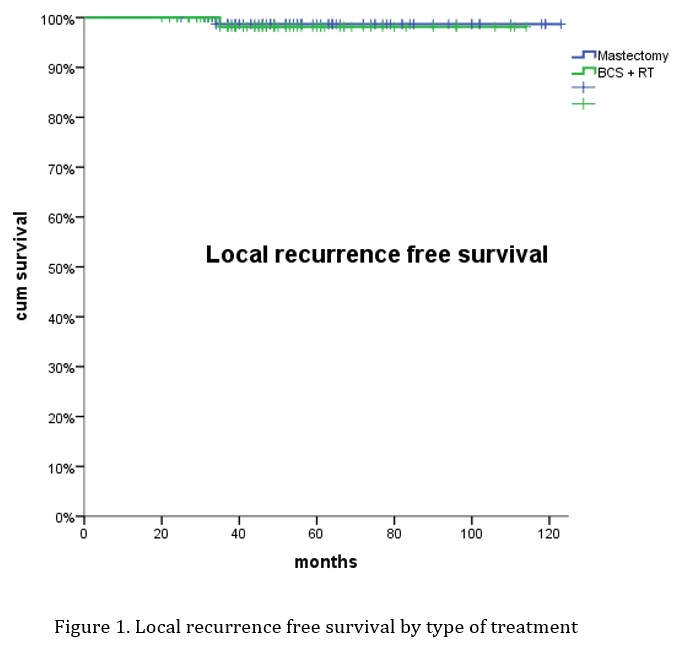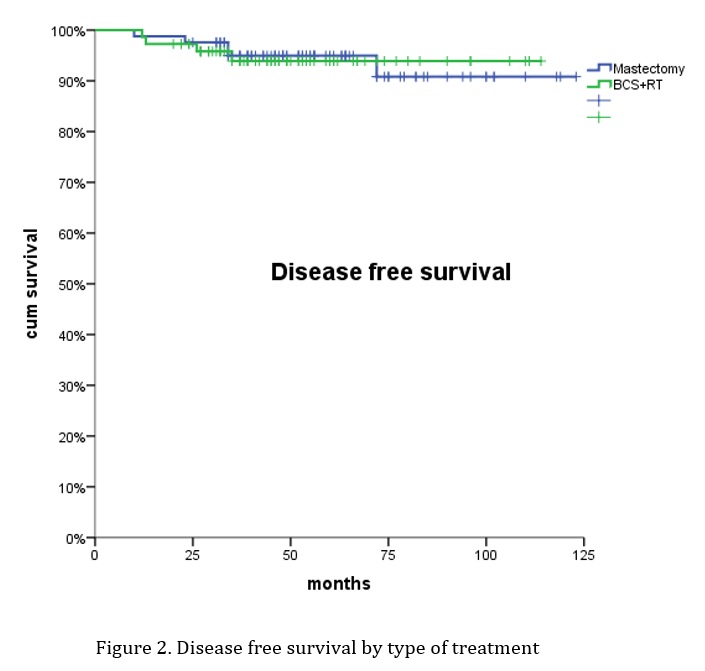Mastectomy vs conservative treatment for breast ductal carcinoma in situ
PO-1184
Abstract
Mastectomy vs conservative treatment for breast ductal carcinoma in situ
Authors: Beatriz Gil Haro1, Cristina De La Fuente Alonso1, Sofía Córdoba Largo1, María Hernández Miguel1, Esther Ramírez Medina2, Mariano Artés Caselles1, Cesáreo Corbacho Cuevas3, Marta López Valcárcel1, Raquel Benlloch Rodríguez1, Joaquín Velasco Jiménez1, Sofía Santana Jiménez1, Olga Engel1, Jesús Romero Fernández1
1Puerta de Hierro University Hospital, Radiation Oncology, Madrid, Spain; 2Puerta de Hierro University Hospital, Gynecology, Madrid, Spain; 3Puerta de Hierro University Hospital, Pathology, Madrid, Spain
Show Affiliations
Hide Affiliations
Purpose or Objective
We aimed to
compare survival and local control rates between treatment with mastectomy or
breast conservation surgery (BCS) plus adjuvant radiotherapy in patients with
breast ductal carcinoma in situ (DCIS).
Material and Methods
We conducted
a retrospective study of 156 patients diagnosed with DCIS from January 2009 to
December 2018. Among them, 83 were treated with mastectomy and 73 with BCS
followed by radiotherapy. Clinical characteristics: Mean age 54 years (30-85);
tumor grade: 1 (27 patients), 2 (48 patients), 3 (81 patients). Radiotherapy:
50Gy, 2Gy/fx (49 patients) or 42.56 Gy, 2.66 Gy/fx (24 patients); +/-10-16 Gy boost:
(40 patients).
Overall survival (OS), disease-free survival (DFS) and local
recurrence-free survival (LRFS) rates were compared between the two treatment
modalities.
Statistics: Kaplan-Meier,
log-rank.
Results
OS rates at 5
and 10 years was 100% in both groups. LRFS rates at 5 and 10 years was 98.7%
for the mastectomy group and 98.1% for the BCS plus radiotherapy group
(Figure 1). Rates of DFS in the mastectomy group were 95% and 90.8% at 5 and 10
years, respectively; and 93.9% at 5 and 10 years for BCS and radiotherapy
(Figure 2). There were no significant differences between groups for DFS or
LRFS. In the multivariate analysis, there were no significant differences;
although young age, proximal margin (<3 mm) and grade III tumors showed a
trend towards significance for recurrence for the whole series.


Conclusion
Conservative
treatment is a good and safe alternative to mastectomy for patients who want to
preserve their breast.